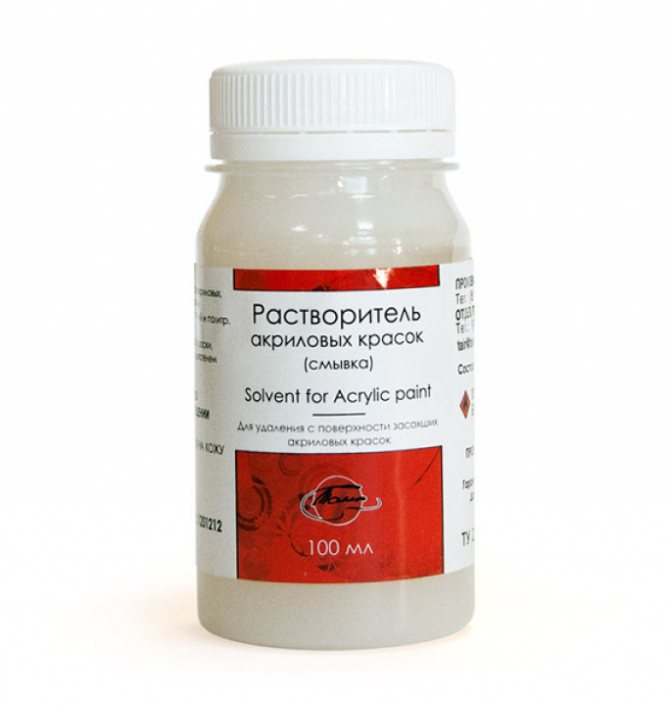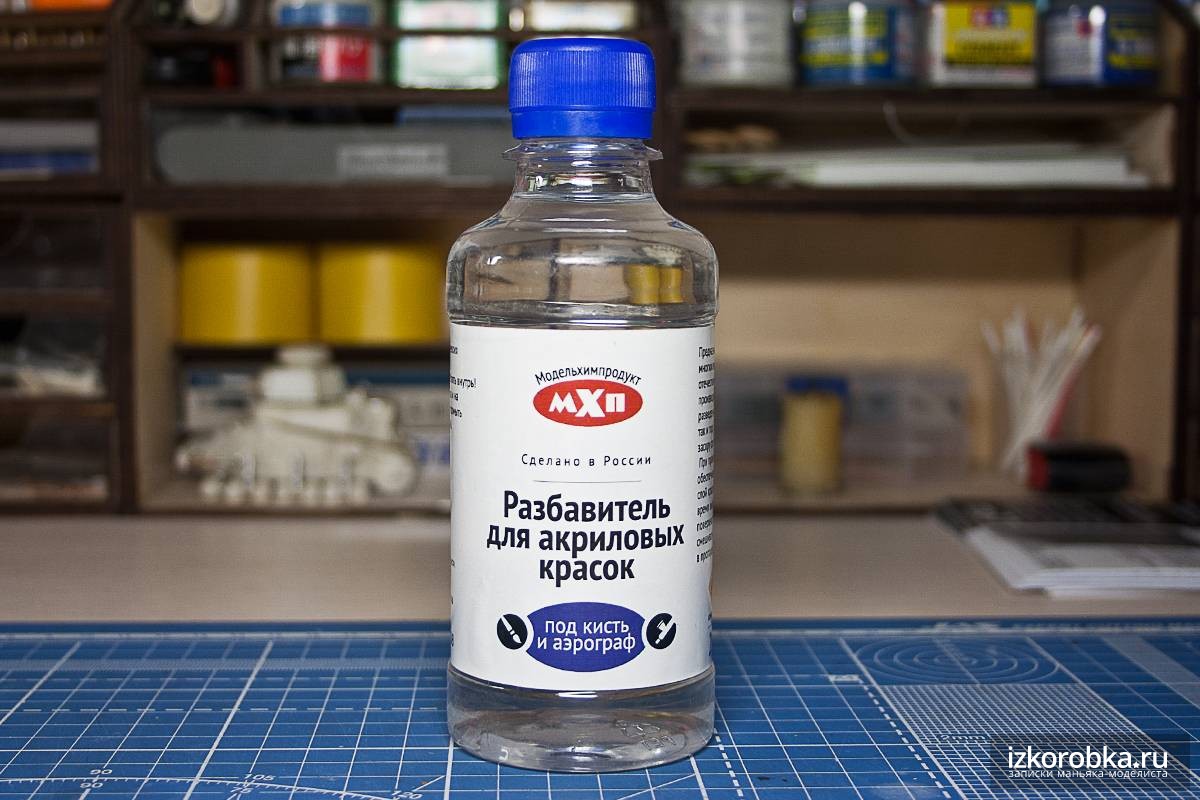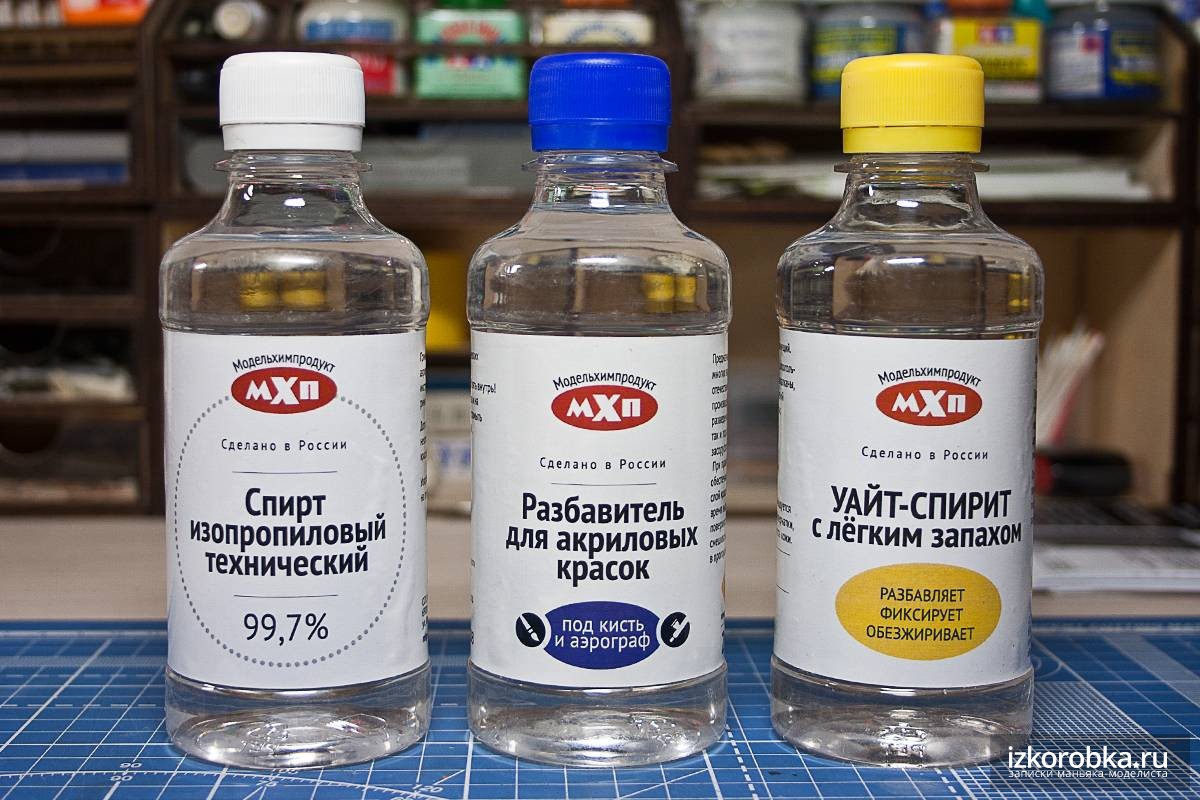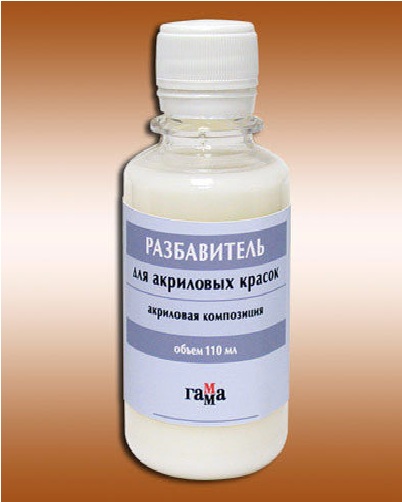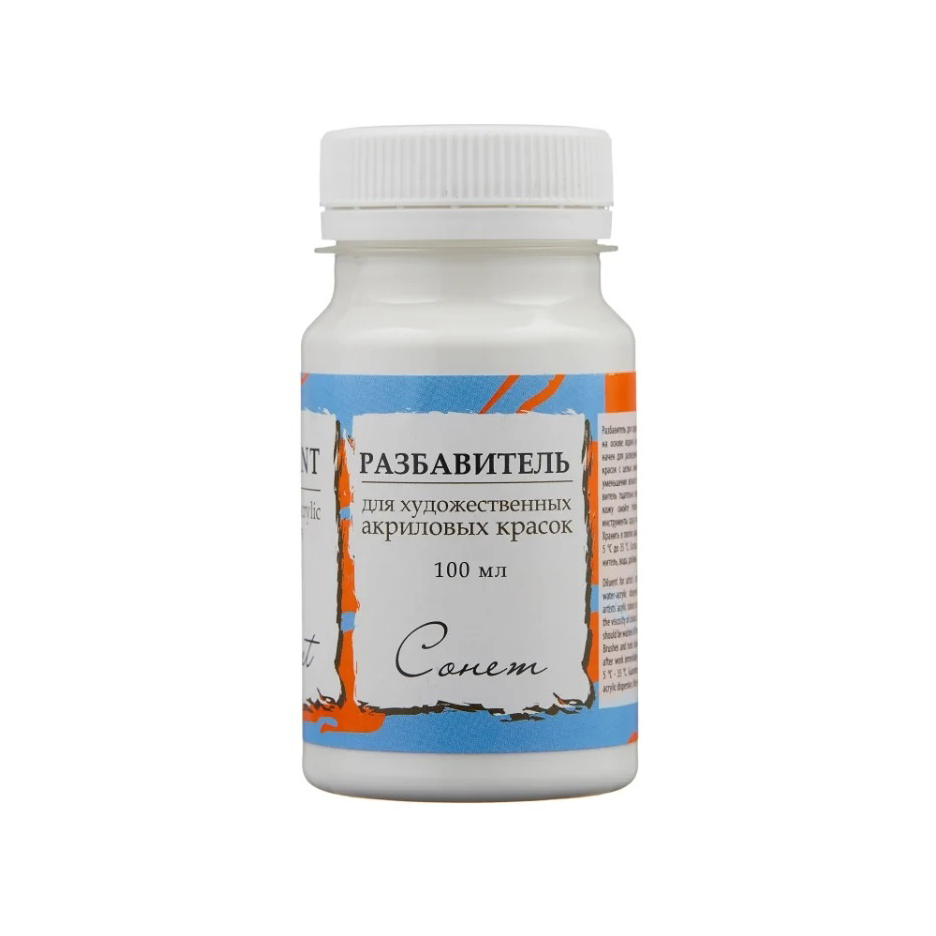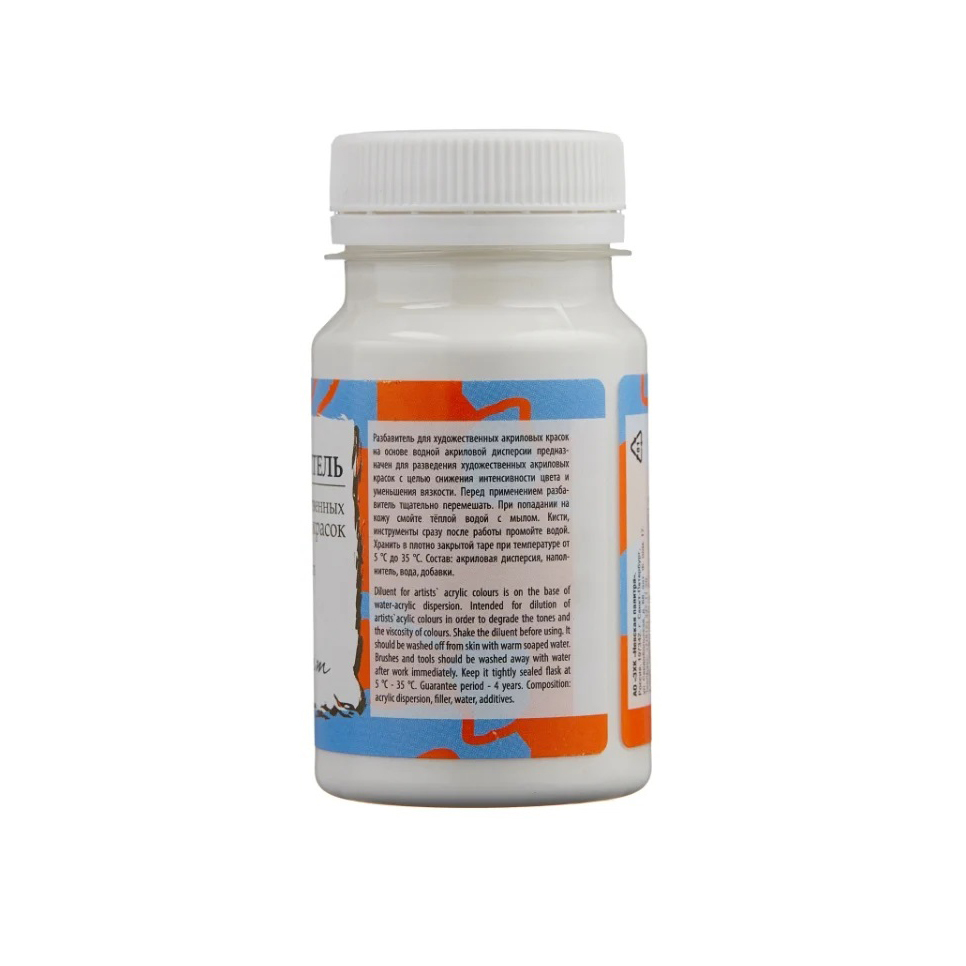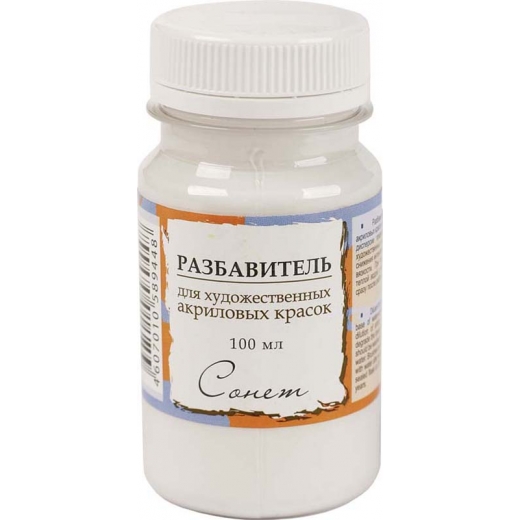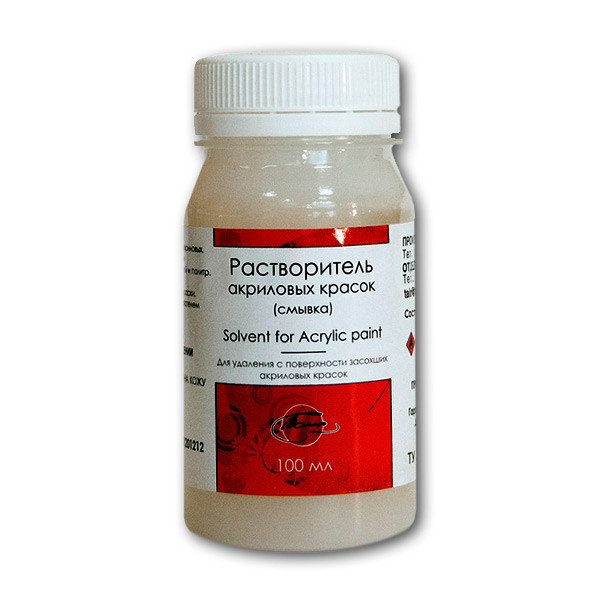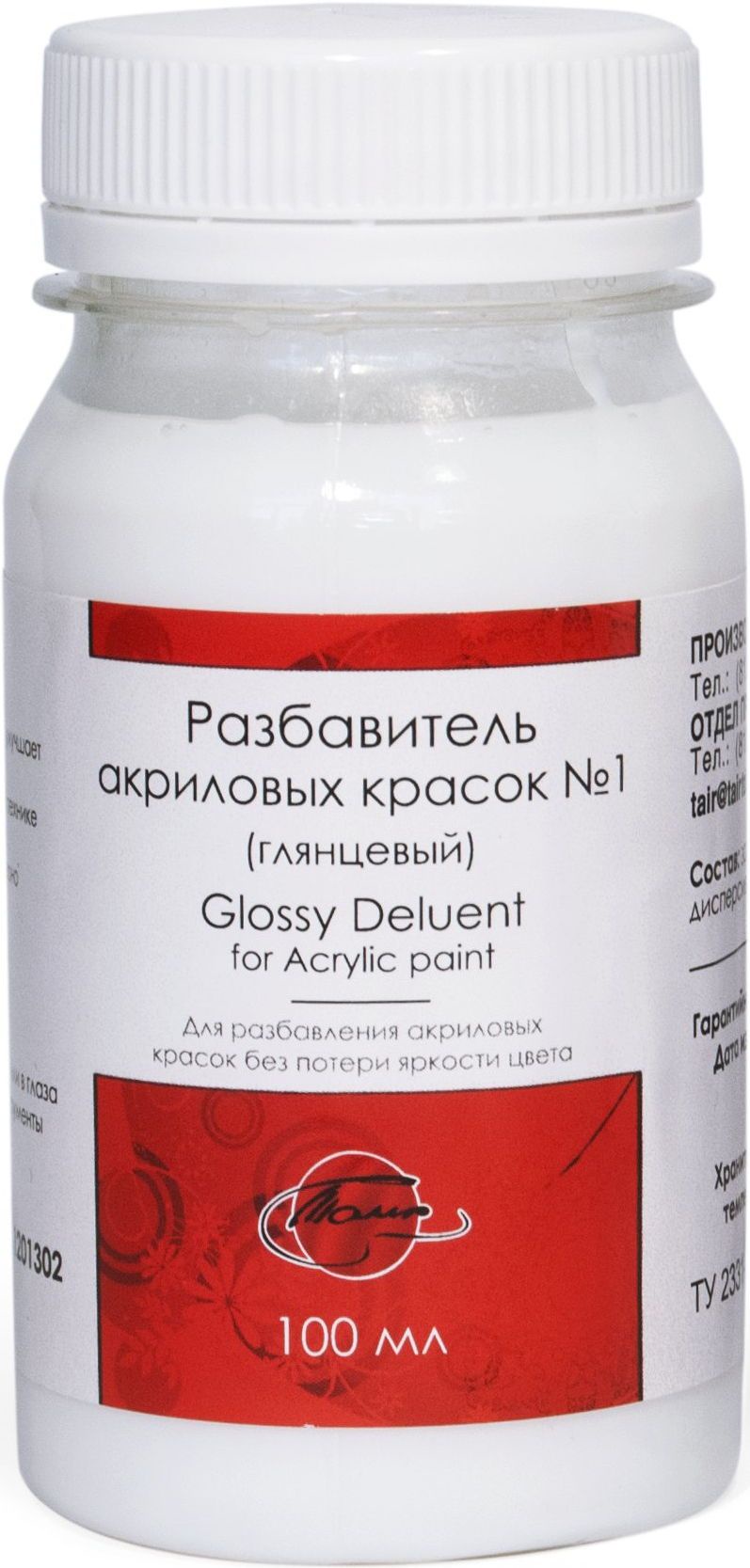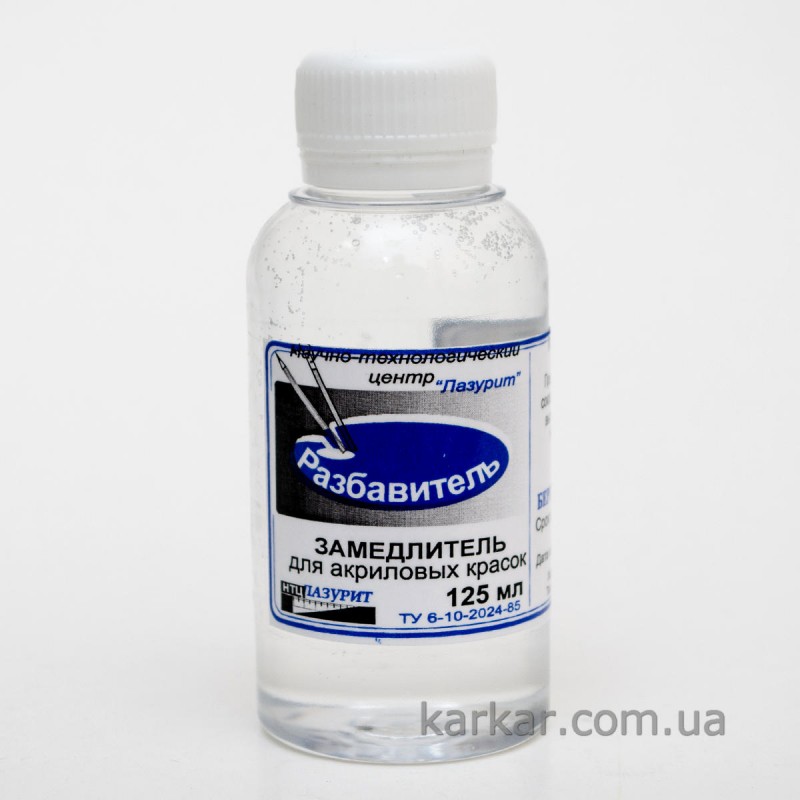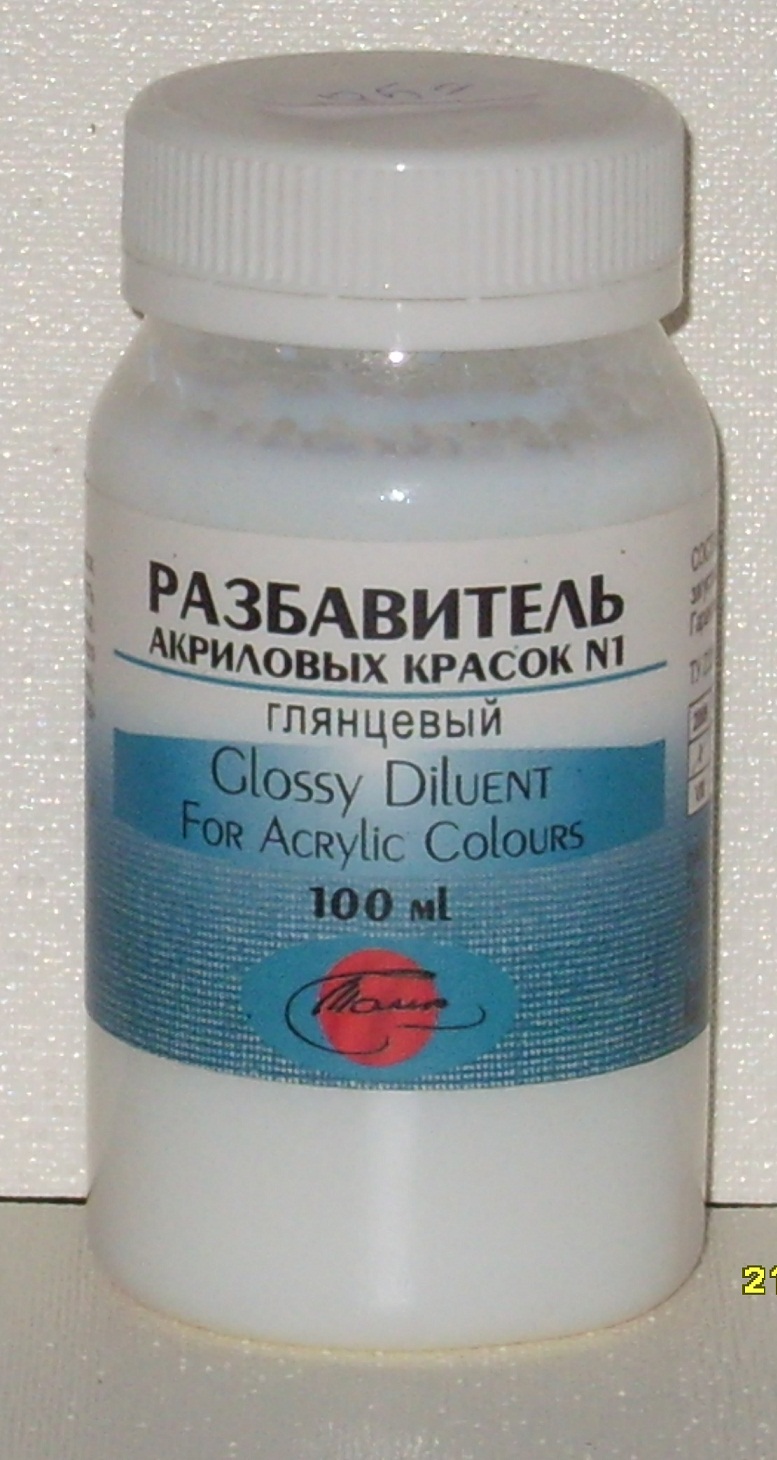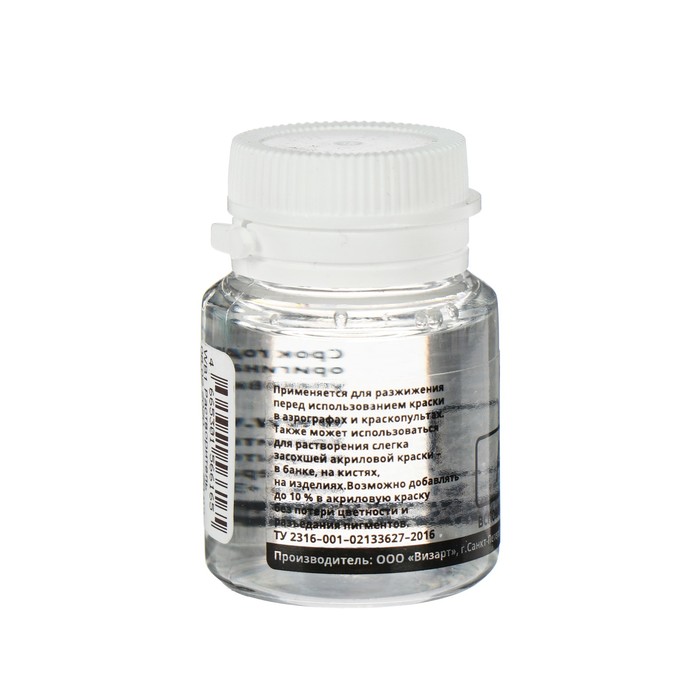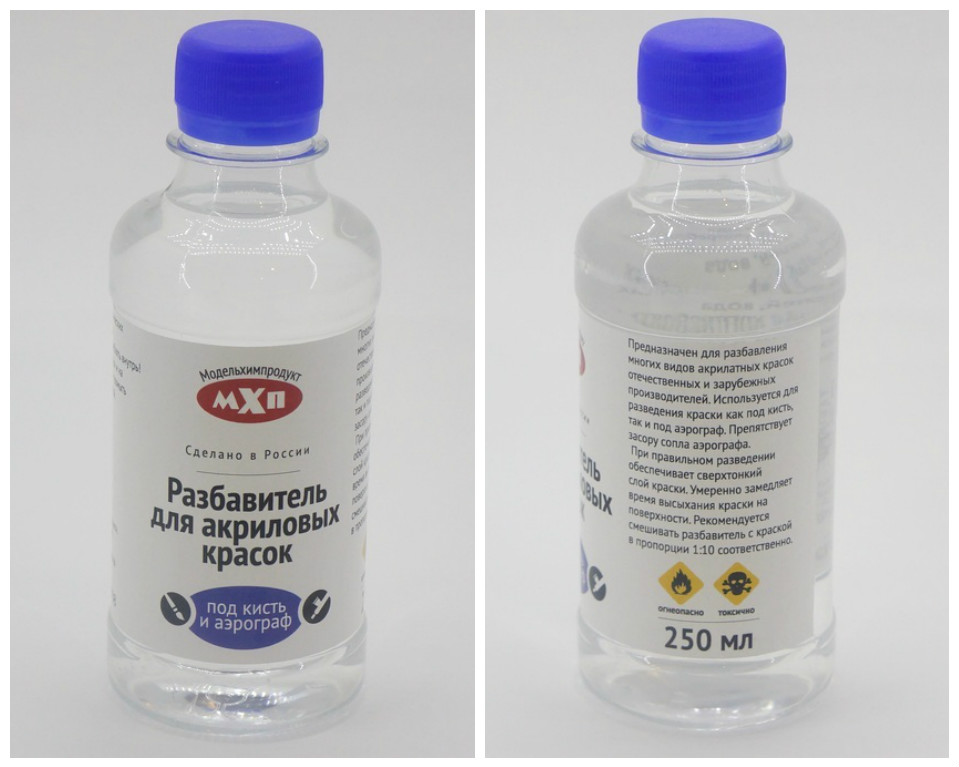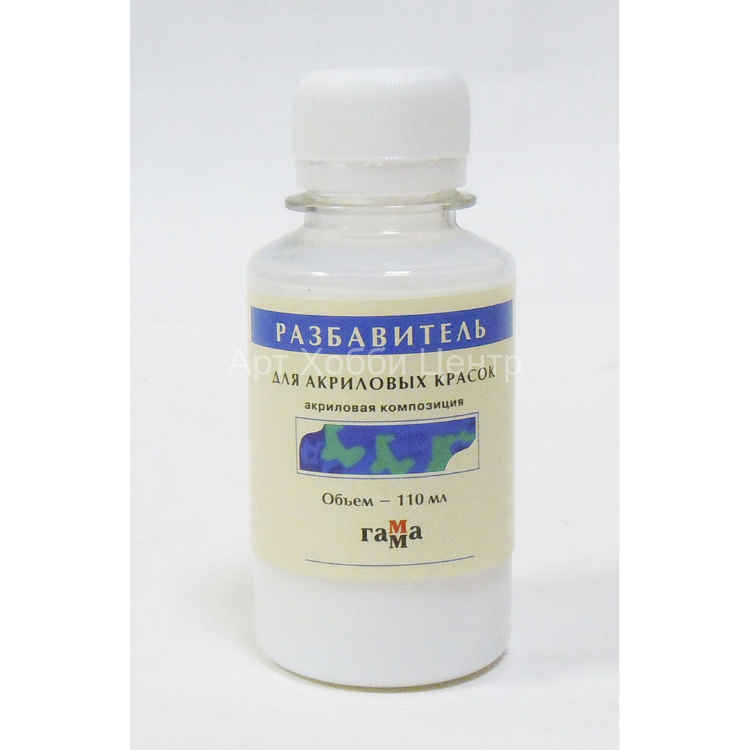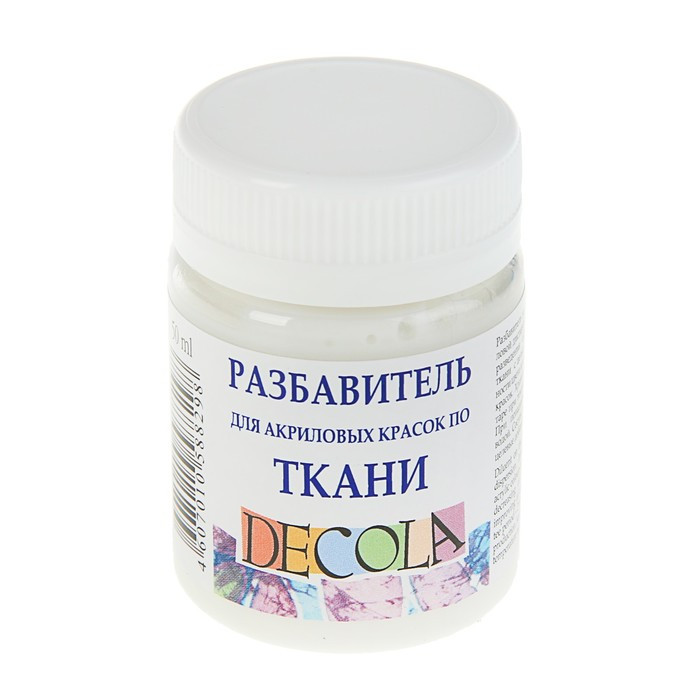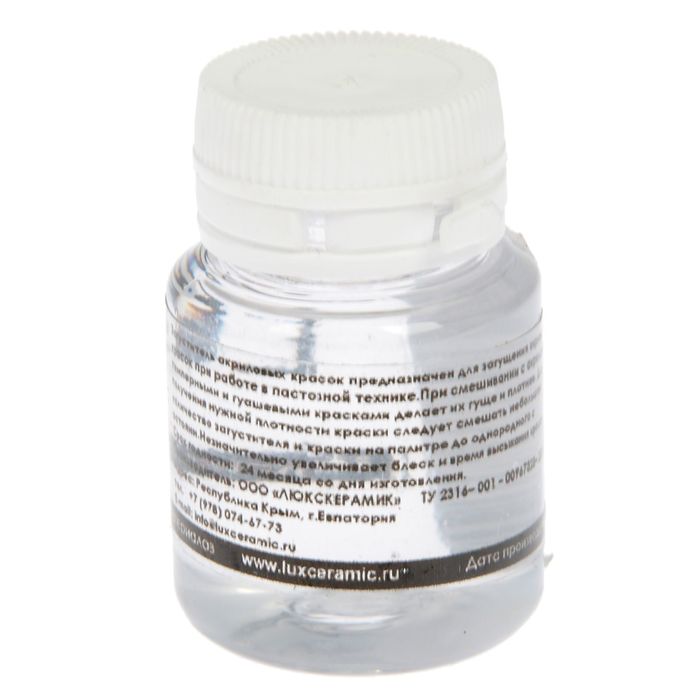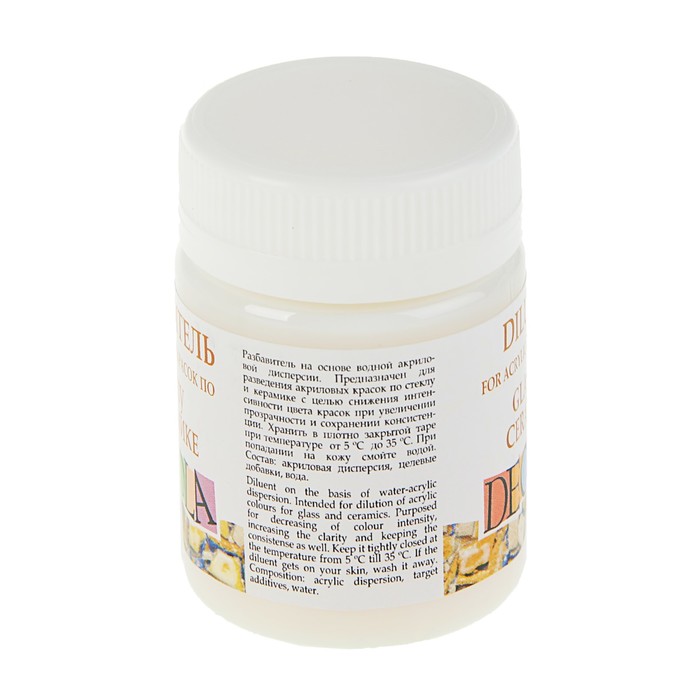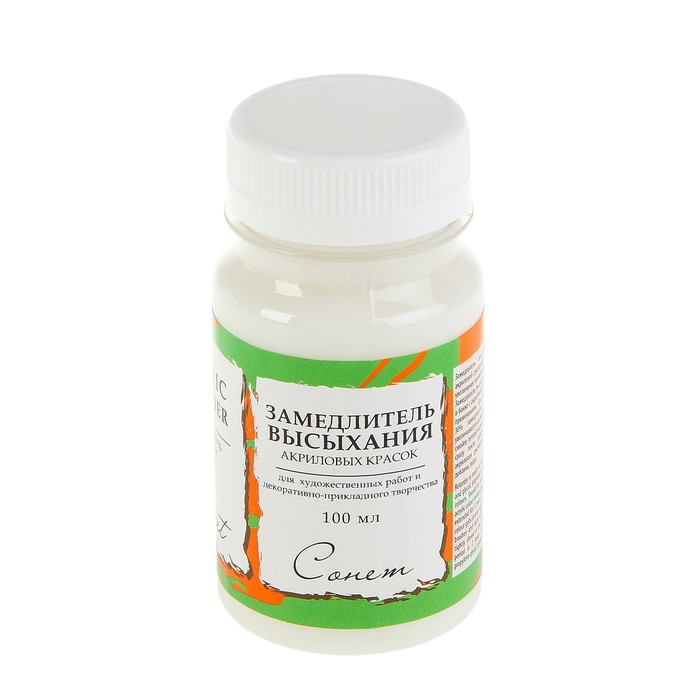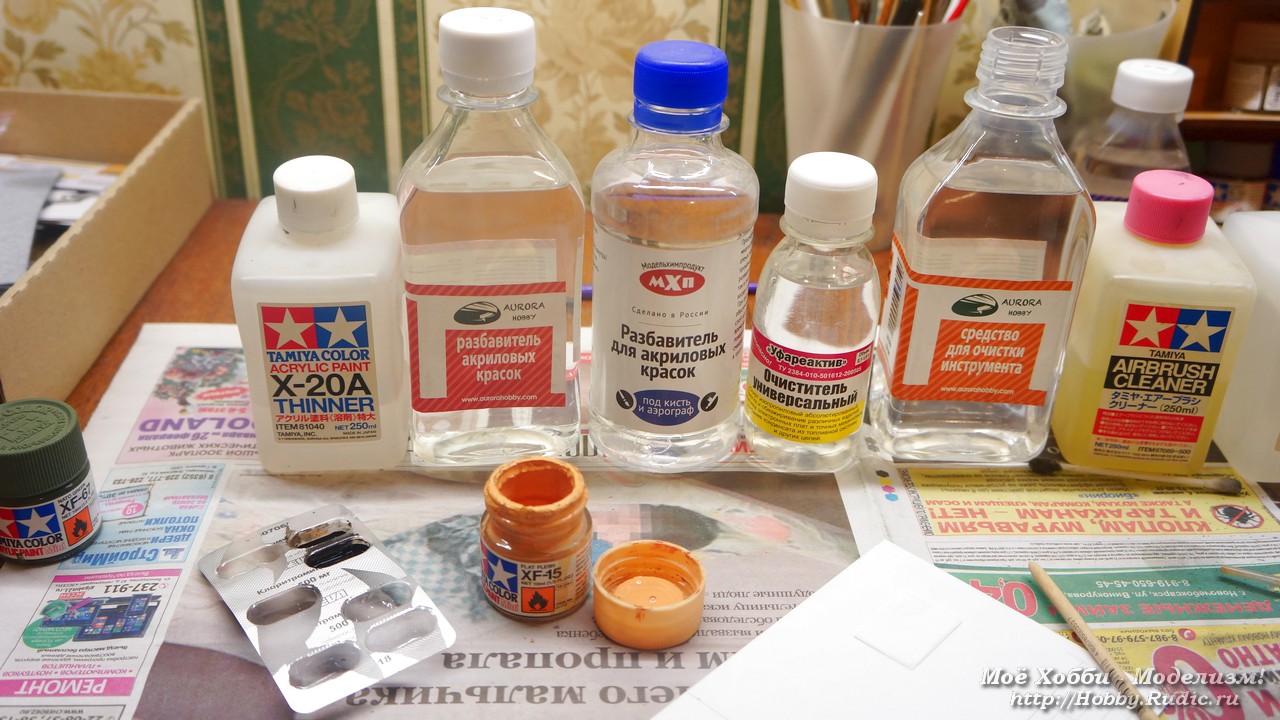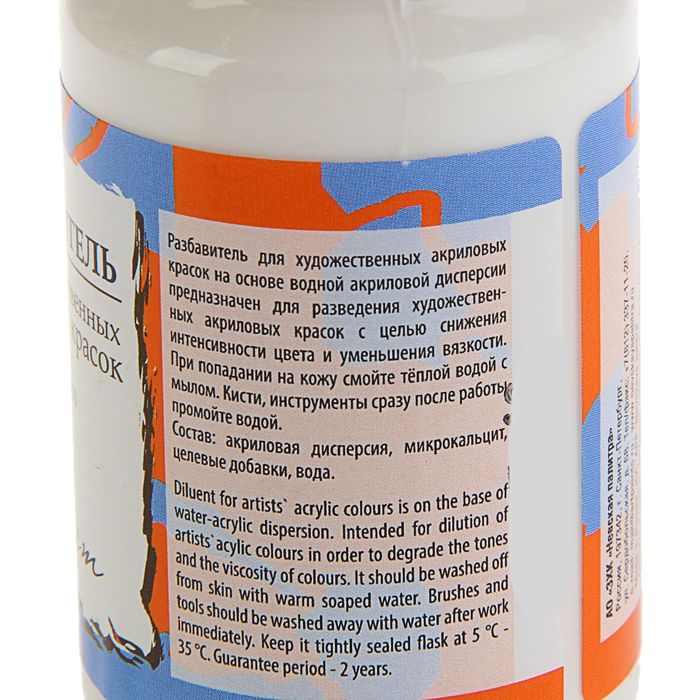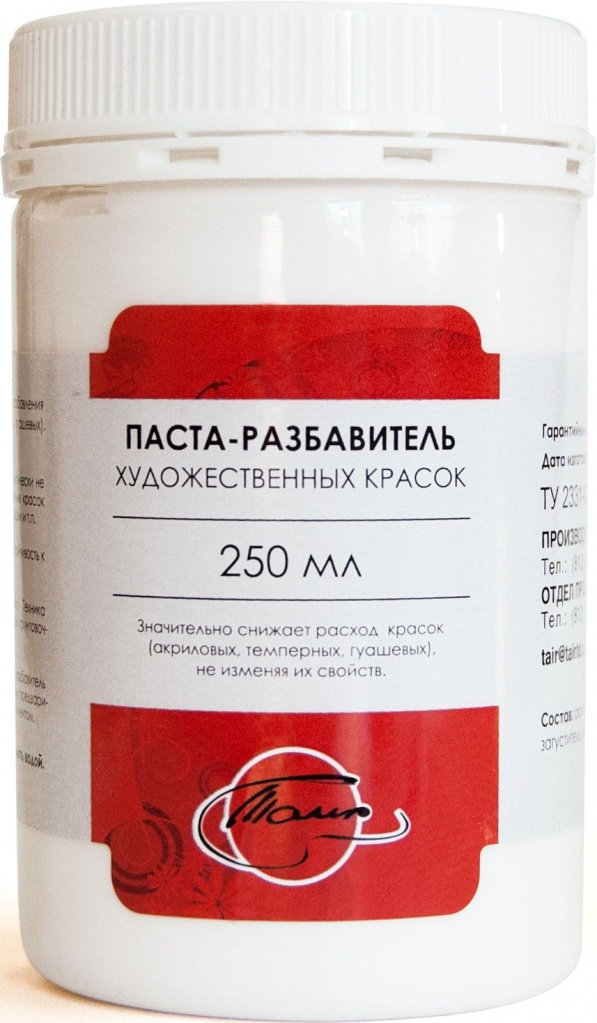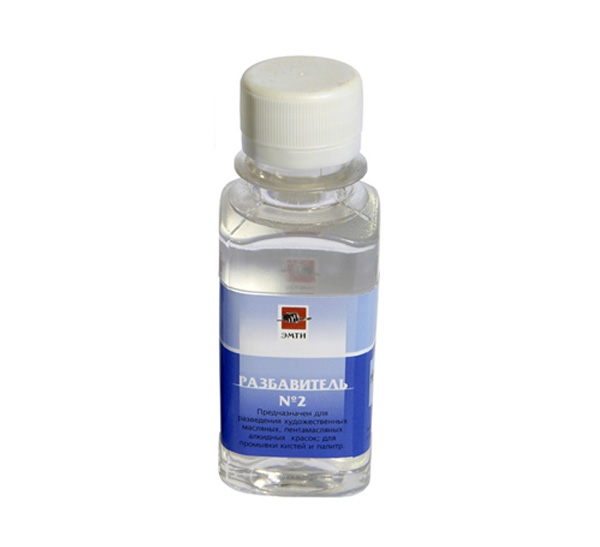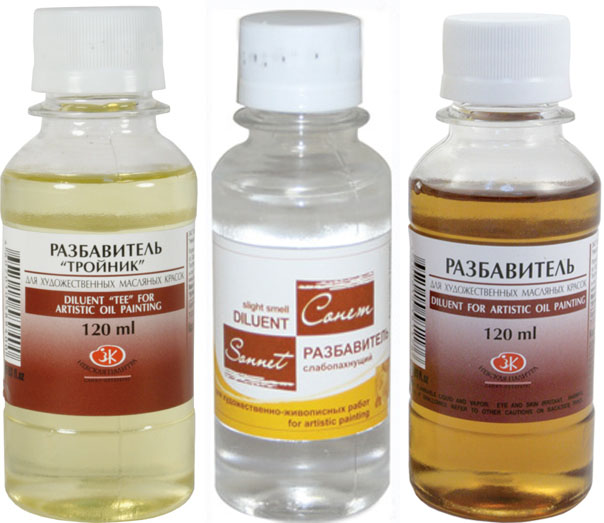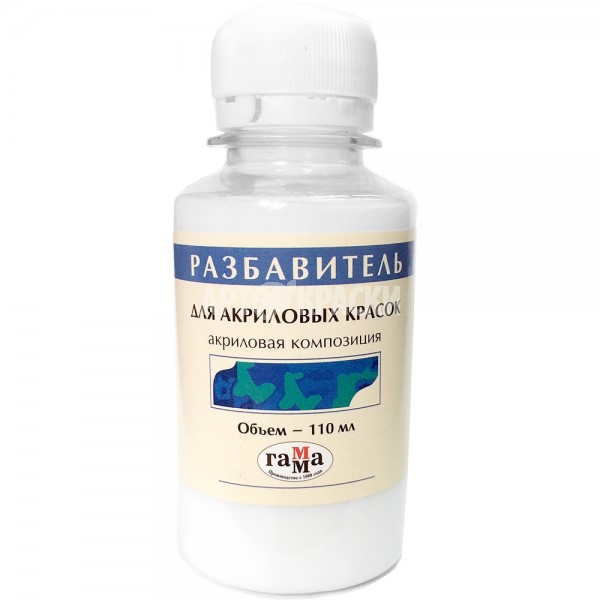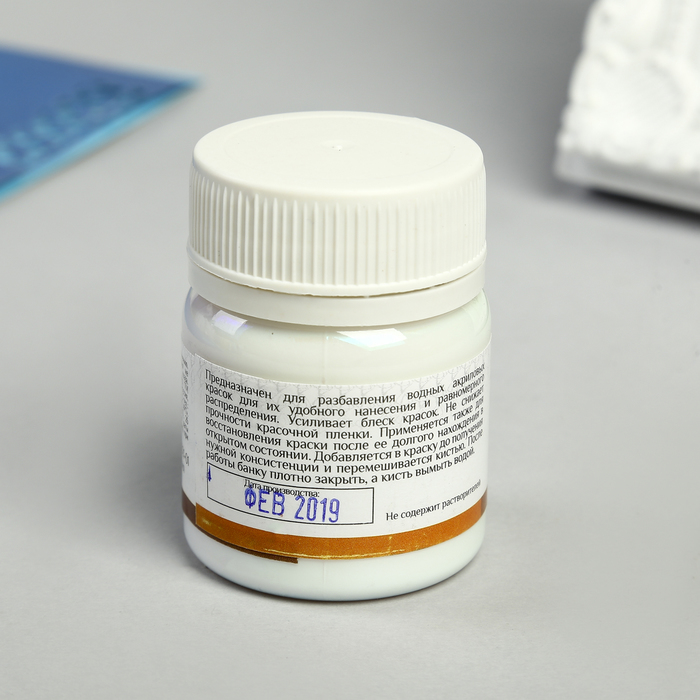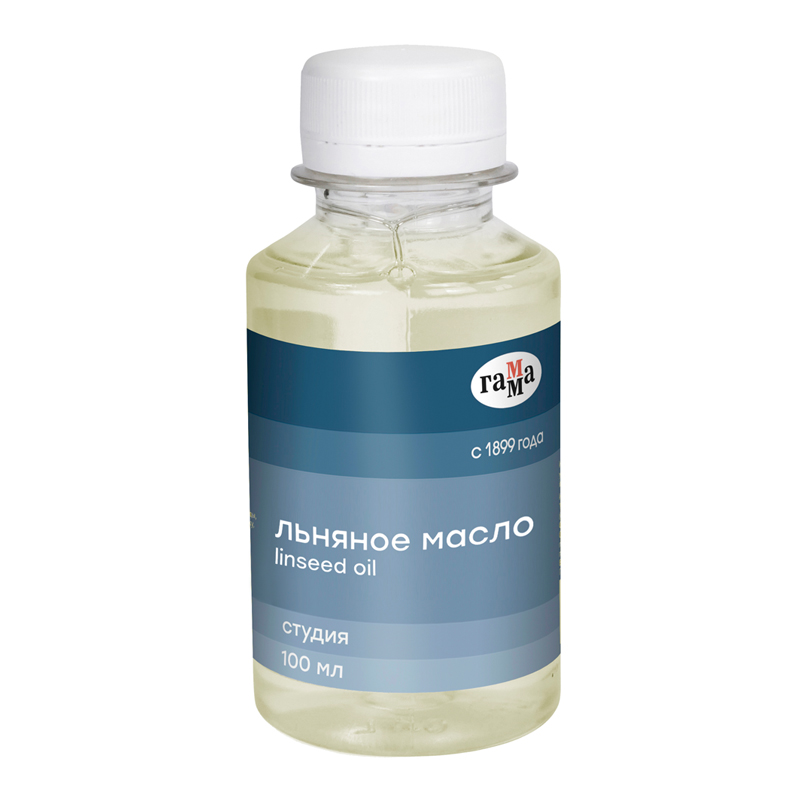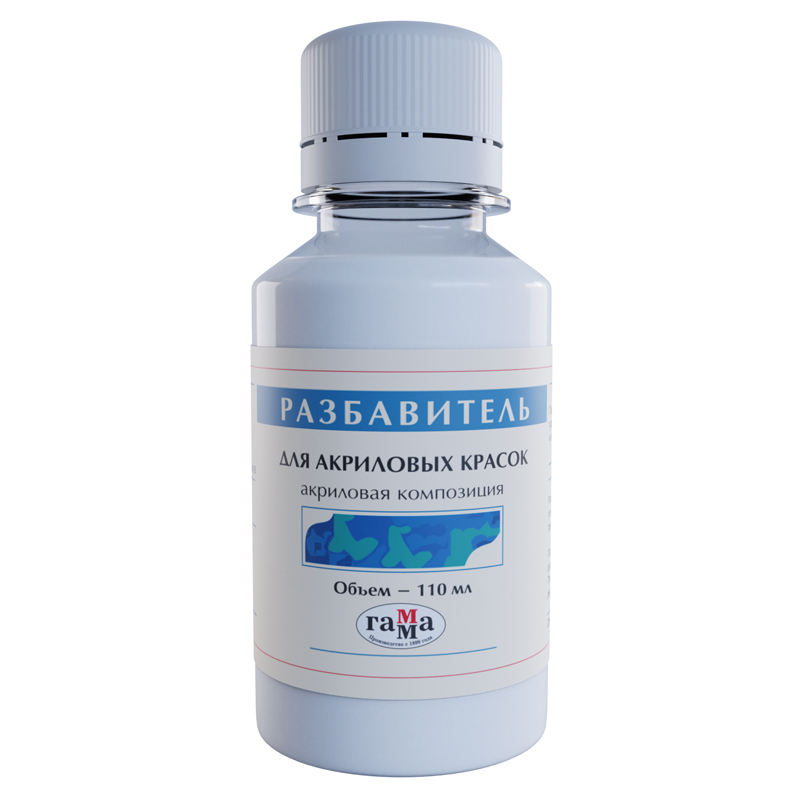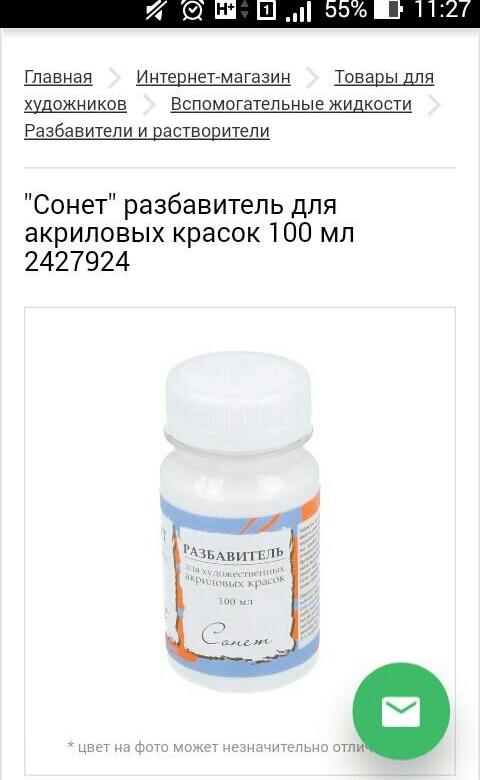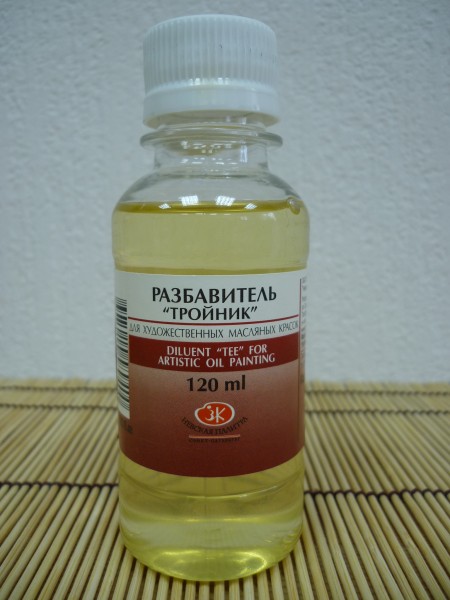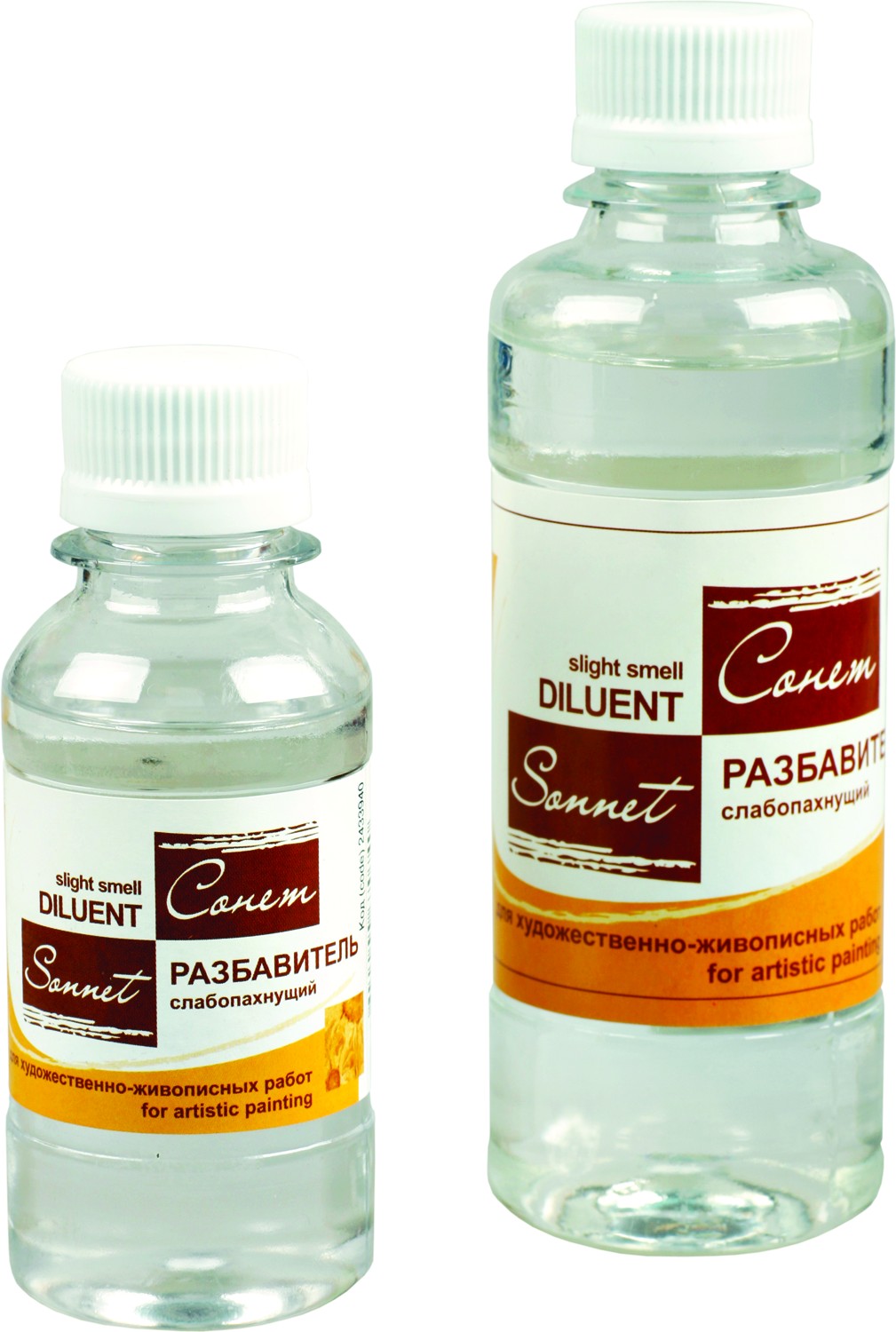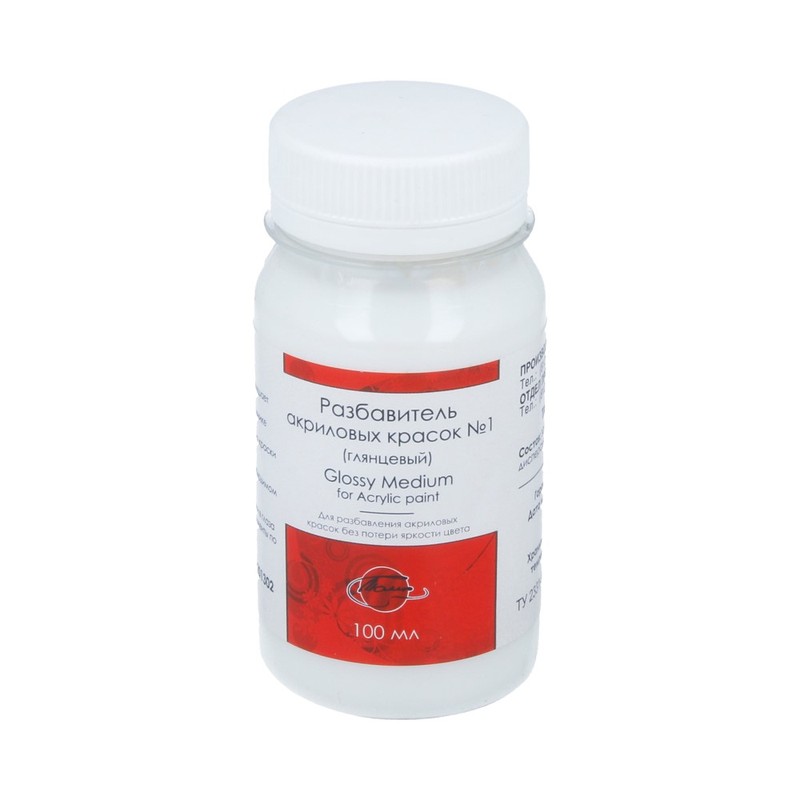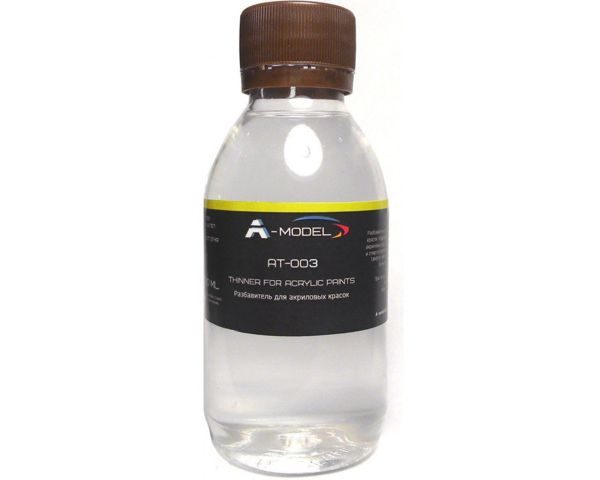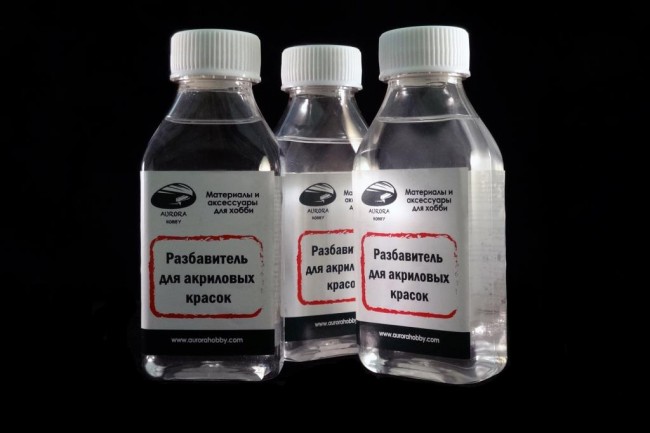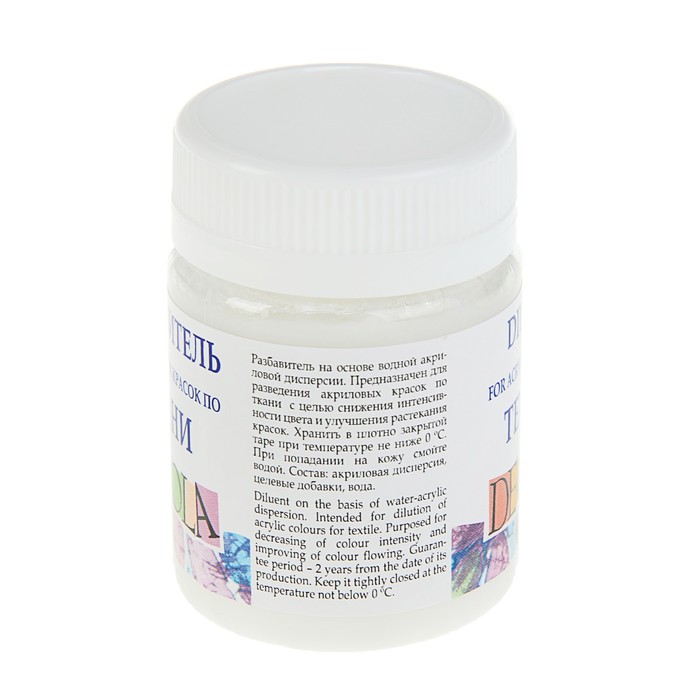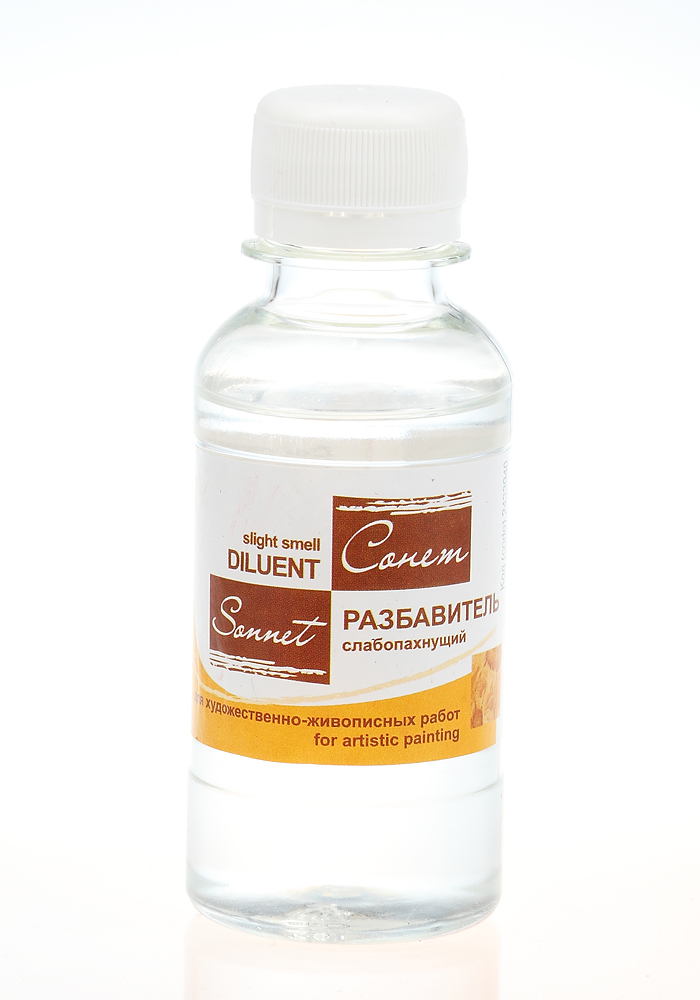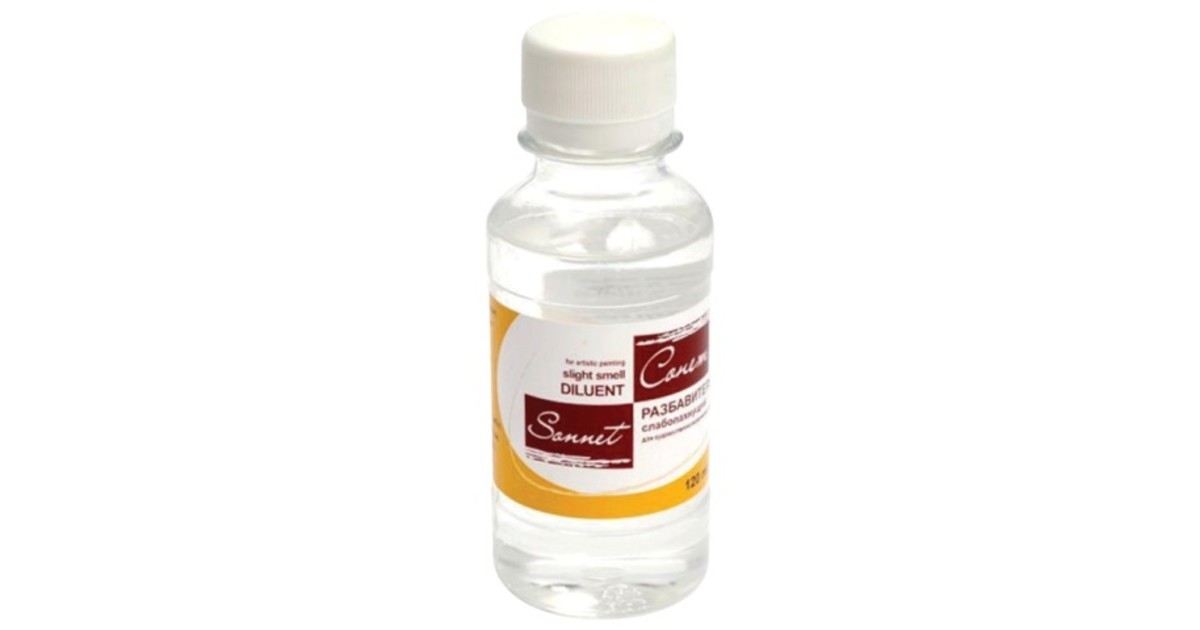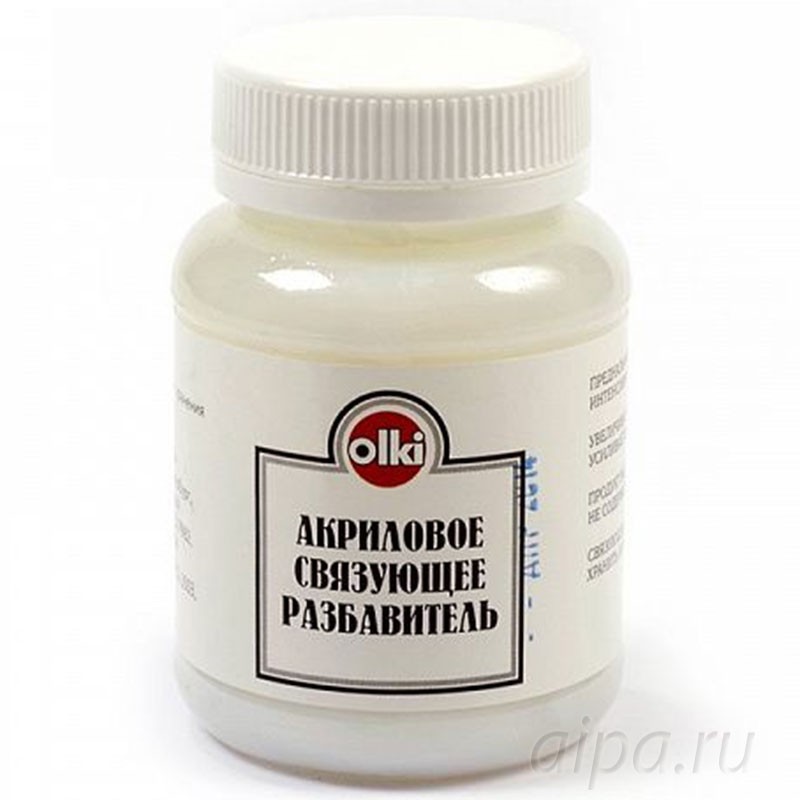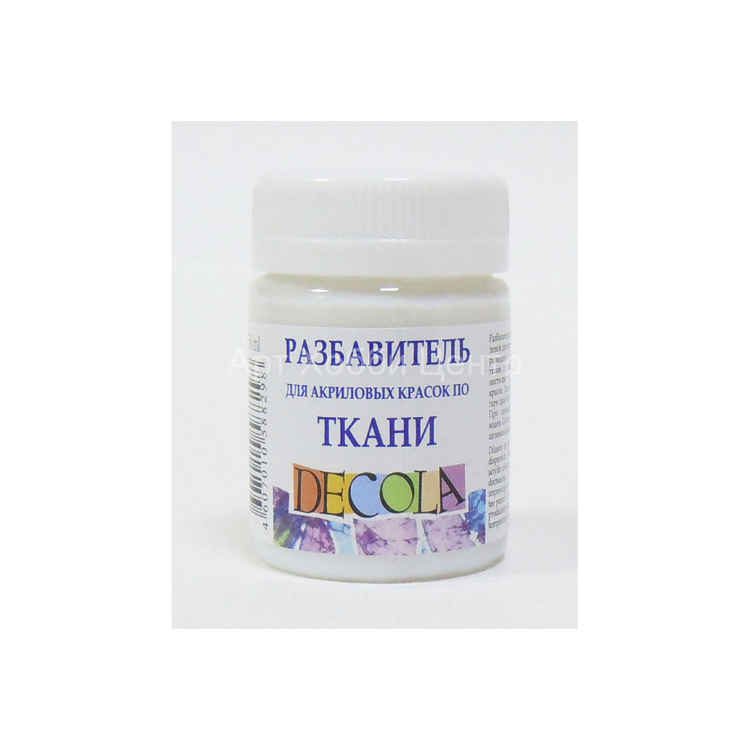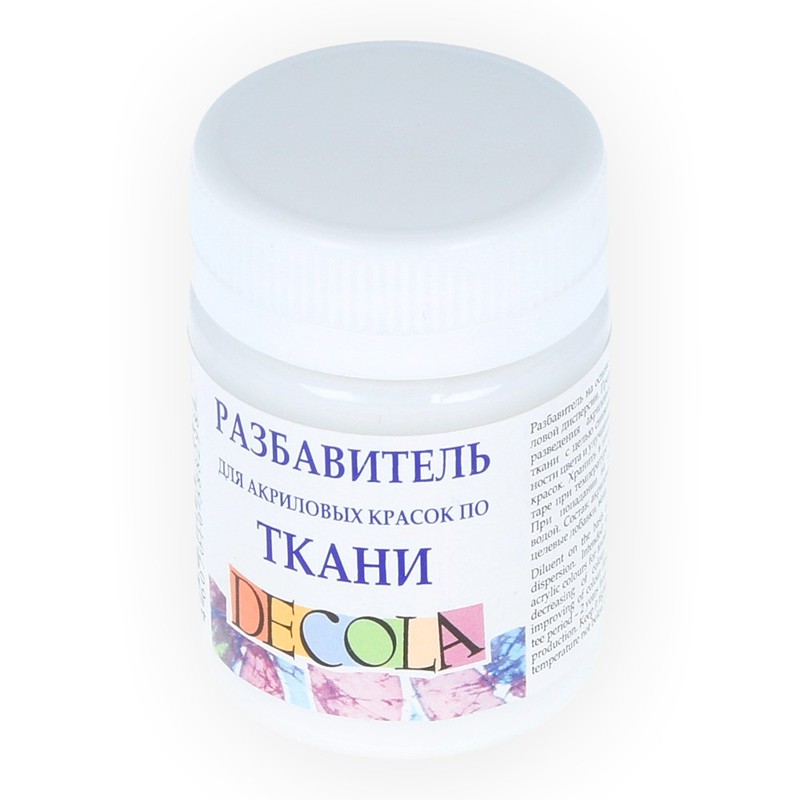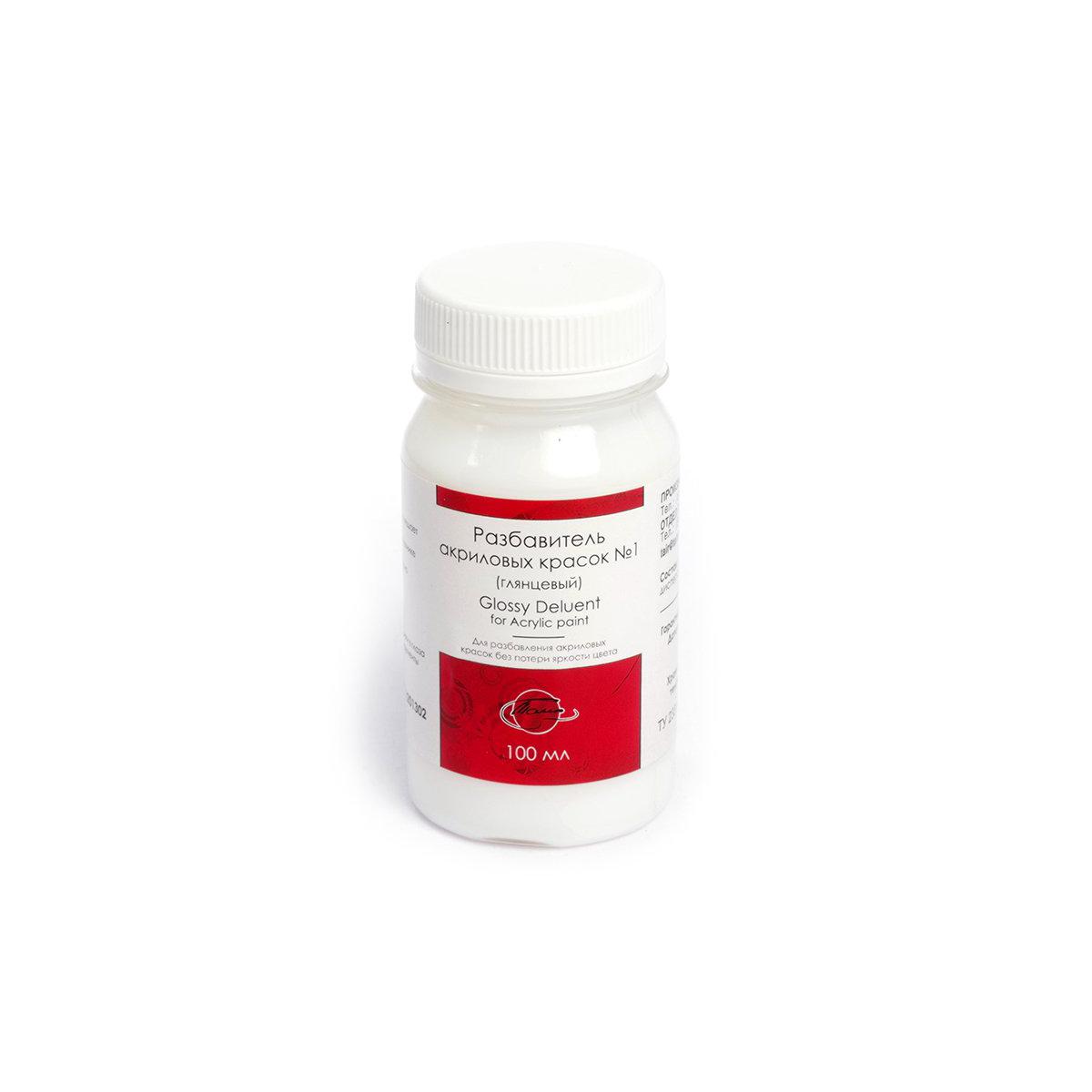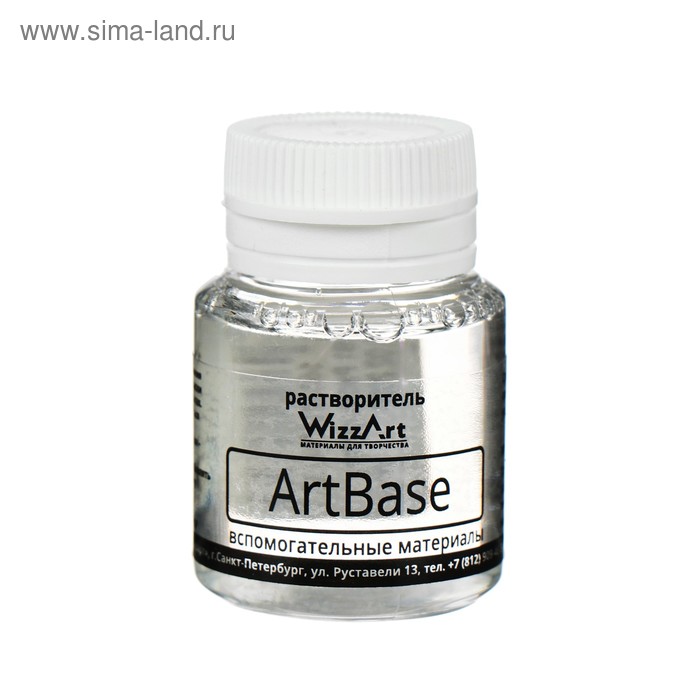How to dilute acrylic paint
Thickened acrylic paint can be thinned in several ways:
- Since this dye contains water, it can be dissolved with the same liquid. But keep in mind that the water must be extremely clean and of high quality, without chemical impurities. To do this, the dried water-based paint must be diluted with water with a construction mixer in a separate container. If you intend to use the entire mixture, dilute directly in the jar. You need to add a little water to avoid making the paint too runny. If you have a rich base, then after dilution with water, the color will fade a little, so you will have to add a coloring pigment.
- Special thinners-solvents for acrylic paint. A huge number of them are produced. The main advantage is improved coating properties and faster drying of the surface. In addition, solvents can impart a matte or glossy finish. The thinner is a clear liquid with a specific odor that quickly evaporates as the mixture dries.
Features of the use of water
Before thinning the acrylic paint with water, make sure that the aqueous liquid is clean. It should also be cold. Be sure to prepare a container for the experiment, in what ratio you need to dilute the paint.
The ratios can be as follows:
- Option 1: 1 applies to the base layer. The paint turns out to be not too thick, lays down evenly, paints over as well as possible.
- Option 1: 2 assumes a structure that does not flow and easily penetrates a brush or roller. The layer is thin and smooth.
- Option 1: 5 has a liquid structure, in which the color is practically not preserved. In this case, you need to add a coloring pigment. This mixture is most often intended for painting curly and small items. It dries quickly but has to be applied in many coats.
- Option 1:15 is more like regular water with a slight tint. Used to create a smooth color transition - a gradient effect.
Features of the use of diluents
Acrylic solvents vary in degree of drying:
- Fast speed is used in cold weather conditions. As you know, the low temperature does not allow the paint to quickly adhere to the surface. With the help of a diluent, this becomes possible.
- Average speed is considered universal. It is mainly used for interior work with normal temperature conditions.
- Low speed is used at elevated temperatures. If the water evaporates too quickly, then the paint will begin to lose its properties, which should not be allowed. A slow solvent will reduce the evaporation rate.
Follow the instructions for storage. Be sure to close the lid tightly and place the solvent container vertically. The room temperature should be cool.
Base of thinners based on paint composition
Thinners for acrylic paints are different based on the main active ingredient:
- Solvent, gasoline and the like. Disappears quickly.
- White Spirit. The evaporation rate is high.
- Kerosene has an average volatility rate.
- Turpentine evaporates slowly.
Types and composition of enamel
Any industrial automotive paint consists of the following components:
-
Binder. O
provides fixation of the car enamel on the painted metal or plastic part or element, due to which the car body acquires a uniform smooth glossy surface; -
Coloring pigment
... The powdery component of the paint, which is responsible for the resulting shade and its saturation; -
Solvent
... Gives the paint and varnish a certain degree of viscosity, which ensures uniform and high-quality spraying.
After applying car enamel to a part or body structure element, the solvent gradually evaporates, leaving a strong and strong composition of color pigment and a bond. The long service life and impeccable performance of the selected automotive paint are determined by the degree of hardness and elasticity.
Depending on the chemical composition, several types of car enamel are distinguished, which is important to consider before choosing a solvent:
-
Alkyd
... The main component of the enamel is oil resin, due to which rapid polymerization of paintwork materials on the surface of the body is achieved under conditions of normal humidity and air temperature. Alkyd paint is not intended for full painting of the vehicle, since it requires repeated application of varnish and the need for its subsequent polishing. The fast drying process of car enamel can lead to the appearance of numerous defects; -
Melamine-alkyd.
The paint is polymerized at a high temperature - from 110 to 140 degrees, it is usually used in factory conditions. Auto enamel creates a durable, reliable and resistant coating on the body surface; -
Acrylic.
The composition contains only two components - a color pigment and a hardener, it received wide demand among motorists due to the absence of the need for subsequent varnish application. After painting with acrylic paint, the surface acquires a rich shade and glossy shine; -
Nitro
... It is used when performing local repair work, the main advantage of car enamel is the fast polymerization process (at an ambient temperature above 20 degrees, it takes half an hour).
According to the degree of concentration, the paint is divided into three groups - high-filled, medium-filled and low-filled. When choosing the type and amount of the solvent used for diluting the car enamel, this parameter must be taken into account, in this case, when painting the body, the paint will not dry out too quickly, which can lead to the appearance of a large number of defects.
Note!
Low-fill car paint should not be thinned with large amounts of solvent
General information
Next, we will consider the most popular of them, because the result and quality of your work will depend on the correct choice of solvent for acrylic paints.
The difference between a thinner and a solvent
Despite the fact that the words are very similar in their meaning, incorrect use of these components can ruin not only the paint, but also the finished result. In order not to have to run to the store for a new can of paint, it is worth remembering these differences.
The thinner does not particularly affect the quality of the product itself, but it changes the color saturation and also changes the density
It is important to remember that when using a thinner, the paint dries faster, and accordingly, you have to work with it in an accelerated mode.
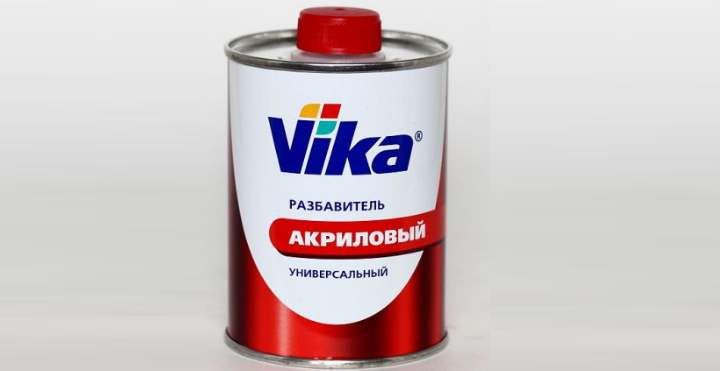
The solvent is useful when the task is to wash off the paint from the surface or remove the dried layer. At the same time, acrylic becomes more liquid, respectively, and the drying time increases significantly.
Types of solvents for acrylic paints
For painting or finishing work, acrylic is never used in its pure form. Due to the rapid drying, there is a high probability of an uneven surface with marks from a brush or sponge. For the same reason, the tools used, especially brushes and rollers, are recommended to be washed immediately after work. Otherwise, after the paint has dried, it will be easier to purchase new brushes than to clean old ones.
How to reanimate dried paint?
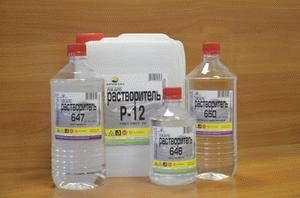 It often happens that the acrylic remaining after staining dries up. The water evaporates and the paint loses its quality characteristics. The irreversibility of the process leads to the fact that only by dilution can the paint be reanimated. You just need to remember that it will not acquire the same properties.
It often happens that the acrylic remaining after staining dries up. The water evaporates and the paint loses its quality characteristics. The irreversibility of the process leads to the fact that only by dilution can the paint be reanimated. You just need to remember that it will not acquire the same properties.
If the acrylic paint is very dry, then it is crushed into powder with a sharp object, and then poured with boiling water. After a few seconds, it is drained and the manipulation is repeated. After sufficient heating, the paint can be mixed. True, she will no longer have a homogeneous structure, but she can carry out painting work.
Some craftsmen manage to resurrect the paint, which has turned into a tight lump. For this, the previous procedures are performed by adding alcohol to the water. Of course, in this case it is not worth talking about good coverage.
What if the acrylic paint is dry?
What if your acrylic paints are dry? Indeed, quite often after painting, a little mixture remains, and it is a pity to throw it away. Over time, it begins to thicken strongly. But this is not yet a reason to be upset, since it is acrylic, unlike other types of paints, that can be restored. Here are some helpful and effective guidelines:
- Initially, you need to determine the degree of how much the paint has dried. Indeed, with a slight drying out, it is much easier to restore it.
- If the mixture has not thickened too much, but clots are already present, simply dilute it with water or a special thinner. In this case, a little alcohol can be added to the water.
- If the paint has dried out excessively, even to the point of hardening, do not be discouraged! The situation is fixable. So, you need to take a sharp tool and try to split the hardened areas. Then grind them to a powder. Then heat the water to a boil and pour it into a jar of crumbs. After holding for 20-30 seconds, drain the boiling water and fill in a new portion of water. Do this 3-4 times. In the last filling, leave the water in the jar and mix with the powdery mass. Such diluted paint has reduced characteristics, but if there is no other way out, then you can use it. In order to improve the performance and properties, you can pour a very small amount of boiling water, and after mixing, add the factory thinner.
- If acrylic paint has thickened and turned into one continuous lump, then it is better to throw it away, because it has practically not retained its properties. However, there are situations when paint is simply necessary. For example, for painting a bench on the street, a table in the country, and so on. In this case, you can reanimate it in the same way as the previous one. But with the difference that the last time you need to dissolve the crumbled paint is not just boiling water, but with the addition of alcohol.
How to dilute acrylic paint
Thickened acrylic paint can be thinned in several ways:
- Since this dye contains water, it can be dissolved with the same liquid. But keep in mind that the water must be extremely clean and of high quality, without chemical impurities. To do this, the dried water-based paint must be diluted with water with a construction mixer in a separate container. If you intend to use the entire mixture, dilute directly in the jar. You need to add a little water to avoid making the paint too runny. If you have a rich base, then after dilution with water, the color will fade a little, so you will have to add a coloring pigment.
- Special thinners-solvents for acrylic paint. A huge number of them are produced. The main advantage is improved coating properties and faster drying of the surface. In addition, solvents can impart matte or gloss.The thinner is a clear liquid with a specific odor that quickly evaporates as the mixture dries.
Features of the use of water
Before thinning the acrylic paint with water, make sure that the aqueous liquid is clean. It should also be cold. Be sure to prepare a container for the experiment, in what ratio you need to dilute the paint.
The ratios can be as follows:
- Option 1: 1 applies to the base layer. The paint turns out to be not too thick, lays down evenly, paints over as well as possible.
- Option 1: 2 assumes a structure that does not flow and easily penetrates a brush or roller. The layer is thin and smooth.
- Option 1: 5 has a liquid structure, in which the color is practically not preserved. In this case, you need to add a coloring pigment. This mixture is most often intended for painting curly and small items. It dries quickly but has to be applied in many coats.
- Option 1:15 is more like regular water with a slight tint. Used to create a smooth color transition - a gradient effect.
Features of the use of diluents
Acrylic solvents vary in degree of drying:
- Fast speed is used in cold weather conditions. As you know, the low temperature does not allow the paint to quickly adhere to the surface. With the help of a diluent, this becomes possible.
- Average speed is considered universal. It is mainly used for interior work with normal temperature conditions.
- Low speed is used at elevated temperatures. If the water evaporates too quickly, then the paint will begin to lose its properties, which should not be allowed. A slow solvent will reduce the evaporation rate.
The effect of diluted paint directly depends on the proportions of the combination of the dye with the thinner. So, you can get a transparent surface, a thin layer or a thick one.
Follow the instructions for storage. Be sure to close the lid tightly and place the solvent container vertically. The room temperature should be cool.
Base of thinners based on paint composition
Thinners for acrylic paints are different based on the main active ingredient:
- Solvent, gasoline and the like. Disappears quickly.
- White Spirit. The evaporation rate is high.
- Kerosene has an average volatility rate.
- Turpentine evaporates slowly.
The nuances of using a solvent
There are no special rules for the use of a solvent. All recommendations depend on the purpose of the staining. Manufacturers produce special solvent compositions that can add new properties to paintwork materials. With their help, you can give them dullness, shine, change the consistency of the mixture. All these characteristics of the solvent are indicated on its packaging. It should describe what exactly a particular composition is suitable for. The fresher the solvent is, the better the result will be.
A small amount of solvent is enough to keep the color vibrant and rich. To obtain a transparent effect, its volumes are increased several times.
If the paint will be applied with a spray gun, the material needs to be made more fluid. For this, only special types of solvent are suitable. It is they who make it possible to give the mixture such a consistency so that the spraying occurs in an even layer.
It is important to understand that the use of such a substance can provoke some changes in the characteristics of paintwork materials, both for the better and for the worse. This applies to shade, strength, drying and external properties.
It has already been noted how solvents are divided according to the drying rate and how they are affected by the temperature index in the place where the compositions are mixed.This is important to consider when choosing the right product.
If the paint will be applied with a spray gun, the material needs to be made more fluid.
How to dilute with water
In its original form, acrylic paint is of a thick consistency, therefore it needs to be diluted. For this, special solvents or agents recommended by the manufacturer are used.
However, you can use a simple and affordable dilution tool - water. This component is initially included in the composition, therefore it does not violate the texture and makes the consistency easy to apply.
It is important to understand that the proportion of water must be strictly observed so as not to spoil the original properties. In addition, for the goals set, only clean and cool water is required, without additional impurities.
In painting, four types of dilution proportions are used:
The ratio is 1: 1. If you add an equal amount of water to the volume of paint, you get a consistency suitable for applying a base coat. The liquid will be thick, but will not stick to the roller or brush, will lie evenly over the surface.
The ratio is 1: 2. If you add two parts of water to one part of the paint, you get a composition of a movable consistency, which creates a thin layer on the surface to be painted. Used on smooth surfaces to reduce the intensity of dark colors.
The ratio is 1: 5. If the amount of added water is 5 times the volume of the paint, a liquid composition is obtained - tinted water, which will penetrate between the villi of the working tool. When applied, a barely noticeable layer is formed, which will look interesting when painting textured surfaces.
The ratio is 1:15. In this case, ordinary water is obtained with a small amount of dissolved dye. Such a composition is used to create smooth transitions between shades, gradient color design.
Measure out the required amount of water with a syringe or measuring cup to comply with the recommended proportions.
Be careful: you need to dilute acrylic paint in small portions of water, poured in gradually. In this case, stirring must not be stopped.
What is the Difference Between Thinner and Thinner
Before choosing one of these tools to solve a problem, it is worth understanding their differences and features. The solvent is a volatile organic liquid such as alcohol or ether. It can also be a mixture of these fluids. It is used to dissolve film-forming substances and give the desired consistency to paints.
Thinner is also a volatile organic liquid used to reduce the viscosity of the paint formulation, thereby achieving a consistency suitable for good application to the surface.
Liquids are quite similar, so they are often confused. Solvents are often used in paint manufacturing and are introduced during the manufacturing phase. The base of the paint and varnish material is a solid or viscous substance. Therefore, the solvent allows you to achieve a form of the composition that is convenient for work. When this substance is added, the paint will remain in a liquid state and will not dry until the surface is covered with it. Due to the ability to influence the structure of the composition, the solvent belongs to rather aggressive products.
The thinners are not as aggressive. Their composition does not dissolve the resin, they only dilute it to the desired degree of viscosity. Dilution is the key. That is, a change in viscosity, but not in structure, therefore they are more gentle.
Solvents are often used in paint manufacturing and are introduced during the manufacturing phase.
What is better to use, is it possible to use water
When the composition has dried up, the question arises of how to dilute acrylic paints. Due to the fact that they contain quite a lot of water, it can also be used to change the consistency for the better.
If the material is dry, water will not help. When added to a jar, a suspension is formed, consisting of pigments and acrylic particles in a liquid. The material will lose strength, coils of the composition will appear on the surface.
You can dilute acrylic with water. But, only strictly observing certain proportions and do it once. Constantly resorting to this method will not work.
You can dilute acrylic with water. But, only strictly observing certain proportions and do it once.
There are many factors to consider when choosing the right dilution mix, including:
- Temperature. The room should have temperature indicators in the range from 15 ° С to 20 ° С heat;
- Composition. You should know what is the degree of purification of the substance, which is planned to be diluted. No impurities are allowed. In the case of water, it must be settled or distilled;
- Proportions. If you make mistakes, then the consistency will turn out to be too thick or liquid. The quality of the material will be spoiled.
You should know what is the degree of purification of the substance, which is planned to be diluted.
In addition to water, thinners and solvents can be used. There are several main groups that are used for paintwork:
- Artistic. They are used for interior decoration and painting.
- Specialized. They are issued for specific areas and take into account the characteristics of these sectors.
- Universal. Can be used with any acrylic paint, regardless of its area of application.
Also, solutions are divided according to the degree of drying:
- Slow. Can be used in high temperature environments. Allows you to slow down the drying of the composition.
- Average. They are used at temperatures from 15 ° C to 25 ° C heat.
- Fast. Can be used at low temperatures, down to -15 ° C.
The latter option is suitable for paints used to paint the facade.
Universal thinners can be used for any acrylic paint, regardless of its area of application.
Choosing exactly what to dilute the composition with, you should rely on the following recommendations:
- When working indoors and painting walls and ceilings, use water as a thinner;
- For working with furniture or wood, diluents are suitable to improve the interaction of paint and wood;
- A solvent is suitable for metal.
It is worth considering the surface on which the composition is applied, and the desired effect.
When working with furniture or wood, thinning agents are suitable to improve the interaction between paint and wood.
How to dilute with solvents
In 90% of cases, solvents are colorless, with a pronounced specific odor. These products are used to change the texture of acrylic paints and obtain a matte or glossy surface. Unlike water, which can add "turbidity" to the color, special thinners do not have such a negative effect.
The proportions of adding such funds depend on the type of proposed work. If there is a lot of solvent, the texture will become translucent, a little - a thick, saturated color will remain. Manufacturers give recommendations for dilution, stick to them.
The use of solvents depends on the air temperature.
When painting in cold weather, use solvents with a high drying rate so that the paint has good adhesion to the surface.
Under normal temperature conditions, use formulations with a medium drying rate. They are considered versatile and suitable for all types of work.
Slow drying solvents are designed for hot weather and prevent water from evaporating too quickly.
It is important to understand that a properly selected solvent improves the performance characteristics of the composition, affects the strength of the coating and the color saturation. Solvents that are compatible with acrylic paints:
Solvents that are compatible with acrylic paints:
gasoline and white spirit - formulations with a high drying rate;
kerosene is the average value of volatility;
turpentine - slow evaporation.
There are positive reviews about RELOCRYL ACRYL solvent, which is specially designed for diluting acrylic paints, varnishes and primers.
If the composition gets on a surface not intended for staining, it is washed off with a solvent-remover. The composition is available in the form of a paste. It is applied to the desired area and left for 10-15 minutes. The wash dissolves the acrylic, the excess can be easily removed.
Regardless of the option chosen, it is important that two rules are observed - the resulting solution should not curl up, the presence of lumps is unacceptable
Thinner types
Water
Water is the most common thinner and is also very readily available. Water must be used filtered or distilled. Paint thinned with water becomes very fluid and drips on hard surfaces. It loses its saturation, and its opacity weakens. Water evaporates from the surface for a long time.
Isopropyl alcohol (isopropanol)
Isopropyl alcohol is commercially available in varying proportions with water. Pure isopropanol evaporates very quickly and must be mixed with water for dilution. With this thinner, paint saturation and hiding power are very good. The colors are vivid. This is because isopropyl alcohol evaporates quickly, leaving behind pigments. Isopropanol is very liquid, like water. The paint, diluted with isopropanol, is sprayed and applied to the surface smoothly, without the effect of "drops". Again, I repeat that isopropyl alcohol evaporates very quickly and needs to be diluted with water (50–65% alcohol, the rest is water), otherwise the paint will dry quickly right in the airbrush as soon as you stop spraying.
Retarders / retarders
These additives slow down the drying time of paints, improve their flow and miscibility. This additive can be added additionally along with the paint thinner. The addition of a retarder helps prevent needle tip clogging quickly (as the ink dries more slowly). This product can also be mixed into undiluted paint so that it does not dry out longer during storage.
Mediums
These are additives that change the properties of acrylic paints. Retarders (retarders) also refer to medians for paints. By adding different mediums, you can achieve different effects. They change the consistency, slow down drying, add the effect of transparency, make the paint matte or glossy.
Many airbrush painters choose to make thinner with their own recipe. They mix different thinners and additives and thus give the paint different properties. In a separate article, I'll show you how to make your own optimal acrylic thinner.
Solvents and thinners for acrylic paints
Finishing work is never complete without the use of paints and varnishes. Today, the most popular is acrylic paint, which belongs to the water-dispersion type. It contains water, a coloring pigment and polymer-based binders - acrylic.
Since there is water in the paint, it evaporates rather quickly, which leads to rapid drying of the painted surface. At the same time, the layer, drying, forms the strongest film that cannot be washed off with water.Acrylic has frost-resistant properties, it does not crack or crumble, does not exfoliate. Therefore, it is customary to use such paint not only for interior finishing work, but also for outdoor ones.
If the purchased volume of paint is not used at once, but is stored for some time in an already opened package or the paint is too thick, there is a need to use a thinner of acrylic paints or ... a solvent. In fact, these two fluids have slightly different tasks. Let's tell you more.
Preparation for work
If, to achieve your goals, it is decided to use acrylic dyes, then you need to start preparing. All their charm lies in the widest range of applications. You can create artwork by painting pictures, use in renovation and decoration, and such paints can even be used to restore furniture.
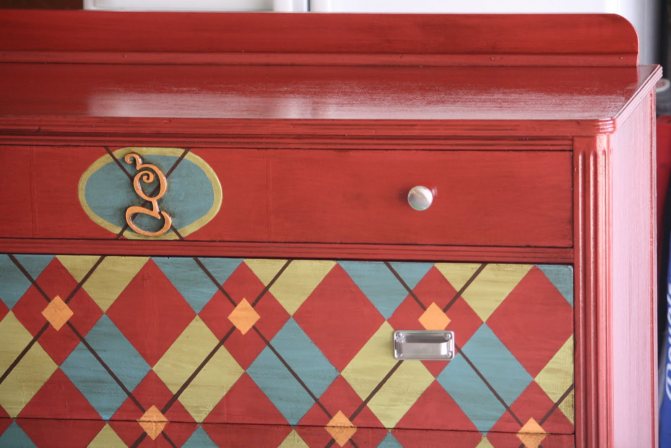
But in its pure form, the use of acrylic paint will not bring the desired effect. Due to the density of the dye, the painted surface will become a reflection of the embossed pattern of the instrument with which the composition is applied. Therefore, use diluted solutions.

Dyes are available for various purposes: for external or internal work, for creating paintings by numbers
Therefore, when answering the question of how to dilute acrylic paint for walls, it is important to study the instructions. The thinner can be either water or an acrylic solvent.
Before diluting acrylic paint with water, you need to make sure that there are no impurities in it, and the temperature is no more than 18-20 °. You will need to prepare small containers for the test dilution. The main thing is that it is possible to determine the amount of ingredients spent on them.
Experienced craftsmen identify several basic proportions for diluted paint, you can mix in different ways, having previously experimented:
- When choosing a ratio of one part of water to one part of the purchased paint, there is no longer the appearance of clots on the painting tool. The surface color is even and uniform, but the consumption of the composition is quite high.
- If the amount of water is doubled, the paint dissolves and becomes quite liquid. Fully saturates the instrument. This composition is easy to brush on, ideal for smooth surfaces.
- When one part of the base is added to five parts of water, the substance becomes too liquid. It is painted with those elements in which it is necessary to emphasize the texture, or parts with complex geometry are selected for coloring.
- When diluted to a ratio of one to fifteen, tinted water is obtained. It is used to create gradient transitions.
Related article: Features of do-it-yourself powder painting
Some manufacturers recommend using only special solvents for acrylics as a thinner. Otherwise, the paint will become like rubber. Therefore, when choosing how to dilute acrylic paint, you should carefully read the instructions.
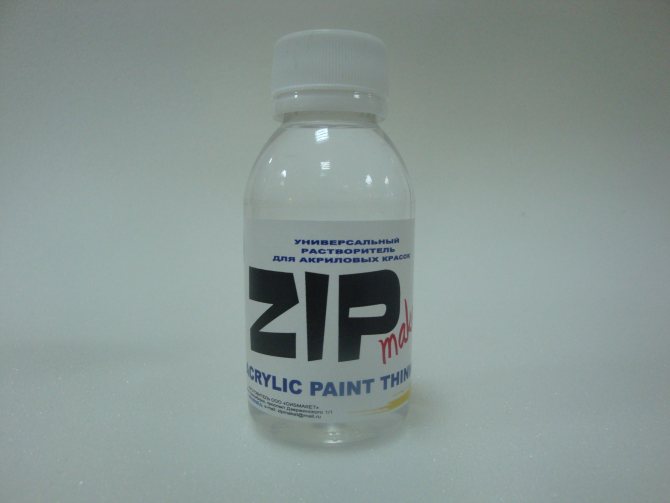
Whatever you choose, the technique for how to dilute acrylic is the same:
- Prepare a container of sufficient volume and a measuring ruler.
- Pour the required amount of base paint into it, check the level with a ruler, mix.
- Prepare the required volume of dilution liquid, check its amount as well.
- Slowly add acrylic thinner to the base stock, stirring constantly, to get a homogeneous mixture.
- If you need acrylic enamel with rigidly specified parameters, for example, for painting an automobile part, for determining the viscosity, use a viscometer.
- Filter the solution if necessary.
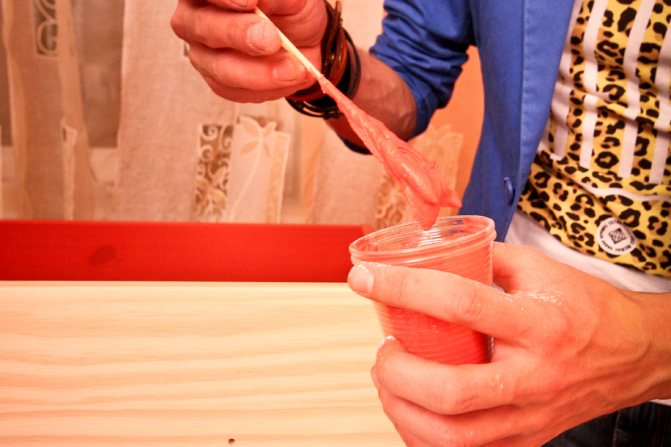
Although it is mostly water-based, once the acrylic paint has dried, it is very difficult to remove it. The tool used should be immediately washed in soapy water or acrylic solvent used.Otherwise, it will not be possible to soak the tools, they become unusable.
